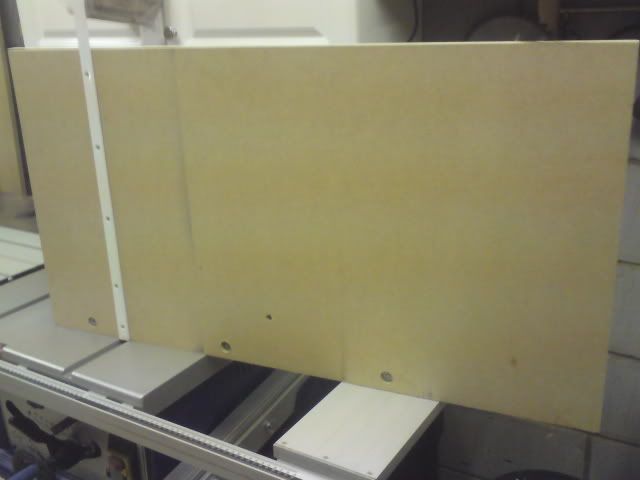wizer
Established Member
- Joined
- 3 Mar 2005
- Messages
- 15,589
- Reaction score
- 1
Right so I've been in the workshop last couple of days. I'm not 100% but I'm going out of my mind reading about woodworking day in day out.
So I thought I'd make a couple of crosscut sleds for an upcoming jewellery box project. Obviously no one will be shocked when I say that the first one hasn't come out too well. :roll: Now, I should start by saying I recently acquired a very posh shooting board which means this is all academic. But I'd still like to know what's gawn wrong.
Here is a pic of what I was building:

..and this was the process:
1. Planed a piece of Iroko til it was a snug sliding fit in the mitre slot. Then ripped it down in strips of roughly 6mm so that it was just beneath flush in the slot.
2. Square up the 12mm MDF board to 600x600mm. **I find at this early point that my TS is not setup very well and It's not making square boards. I nearly stopped here but I reasoned that the edges of the board didn't need to be square for this.
3. Planed up a 2x4 and fixed it to the base board square to one edge.
4. Scratched my head wondering how the **** I was going to make the runners square to the fence (remembering that the back edge of the MDF base was not square to the edge that the fence was squared to.
5. I Decided to fix one end with a screw and then use a combination square to set the other end the same distance from the edge as the other end. (does that make sense?) Then drive some more screws to secure.
6. Use double stick tape on the other runner, slide it in under the base board with the other runner in place. Lift it so that it stuck in place. Then secure with screws.
7. Fix the back fence flush with the back of the board (assuming no need to make it square to anything).
8. Square the blade with the wixey thing and then make a through cut with the sled.
9. Make a test cut with a board and check with an engineers square.
(sounds quick when you read it like that, still took 5hours over 2 days tho :shock: )
The cut was off by about a degree or two. Not much, but it would have been nice to get it nearer to reduce work on the shute. I was un prepared and only decided to make it when I got in the workshop yesterday, so wasn't following a plan or copying someone elses design. "He's makin' it up as 'e goes along!"
So any ideas what went wrong?
Oh and please. no safety lectures. I intend to fix a perspex guard over the top and a block of wood at the back to cover the blade as it goes through when it's finished.
So I thought I'd make a couple of crosscut sleds for an upcoming jewellery box project. Obviously no one will be shocked when I say that the first one hasn't come out too well. :roll: Now, I should start by saying I recently acquired a very posh shooting board which means this is all academic. But I'd still like to know what's gawn wrong.
Here is a pic of what I was building:

..and this was the process:
1. Planed a piece of Iroko til it was a snug sliding fit in the mitre slot. Then ripped it down in strips of roughly 6mm so that it was just beneath flush in the slot.
2. Square up the 12mm MDF board to 600x600mm. **I find at this early point that my TS is not setup very well and It's not making square boards. I nearly stopped here but I reasoned that the edges of the board didn't need to be square for this.
3. Planed up a 2x4 and fixed it to the base board square to one edge.
4. Scratched my head wondering how the **** I was going to make the runners square to the fence (remembering that the back edge of the MDF base was not square to the edge that the fence was squared to.
5. I Decided to fix one end with a screw and then use a combination square to set the other end the same distance from the edge as the other end. (does that make sense?) Then drive some more screws to secure.
6. Use double stick tape on the other runner, slide it in under the base board with the other runner in place. Lift it so that it stuck in place. Then secure with screws.
7. Fix the back fence flush with the back of the board (assuming no need to make it square to anything).
8. Square the blade with the wixey thing and then make a through cut with the sled.
9. Make a test cut with a board and check with an engineers square.
(sounds quick when you read it like that, still took 5hours over 2 days tho :shock: )
The cut was off by about a degree or two. Not much, but it would have been nice to get it nearer to reduce work on the shute. I was un prepared and only decided to make it when I got in the workshop yesterday, so wasn't following a plan or copying someone elses design. "He's makin' it up as 'e goes along!"
So any ideas what went wrong?
Oh and please. no safety lectures. I intend to fix a perspex guard over the top and a block of wood at the back to cover the blade as it goes through when it's finished.






